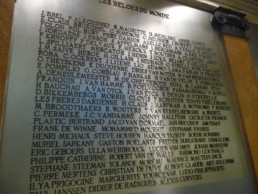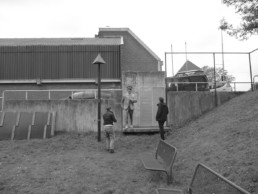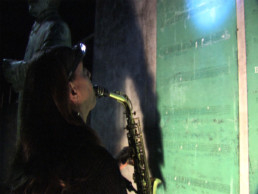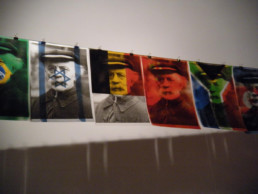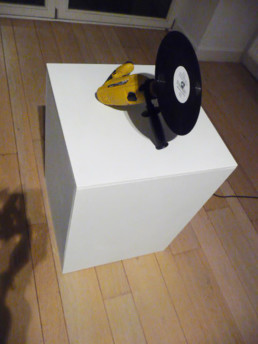Once upon a time the Internationale, 2010
Site-specific project, for the exhibition European Education, curated by Roberto Pinto, Gallery Artecontemporanea, Bruxelles
Sax: Georgeanne Kalweit
In a former bank there is a big stone plaque with all the names of the famous Belgian characters, among which the name of the famous International musician, Pierre De Geyter, does not appear. On the day of his birth the author was honored in front of the statue dedicated to him, where a musician played the famous anthem backwards. For the exhibition, acetate sheets are hung on a cable that runs through the gallery space. On them are multiple photocopied portraits that are then stencil sprayed with the colored flags of the 50 countries that have adopted the original version of the anthem. Finally, the song of the hymn was etched on a vinyl first cut, attached to and turned by a drill. The disc is modified during the listening process: every time it is played, the aesthetics of both the sound and the object are changed, until the song is deteriorated and the audio disappears. “In this way, symbols of work and changes in progress are clarified and revitalized and the installation becomes a synthetic and effective expression of the passage of time and of the ideas that are its daughters”
_
In una ex banca c’è una grande lapide sulla quale compaiono i nomi di tutti i personaggi famosi belgi, ma non è presente il nome del celebre musicista dell’Internazionale, Pierre De Geyter. Nel giorno della sua nascita l‘autore è stato omaggiato davanti alla statua a lui dedicata con l’azione di un musicista che ha suonato il famosissimo inno al contrario. Per l’occasione, su un cavo che attraversa lo spazio della galleria, è stata appesa l’immagine fotocopiata e duplicata su acetato del suo ritratto. Sullo stesso foglio sono impresse con lo spray le bandiere colorate dei 50 paesi che hanno adottato la versione originale dell’inno. Infine, il brano dell‘inno è stato inciso su vinile in pronto ascolto, applicato e fatto girare da un trapano. In questo modo il disco viene modificato durante il processo di ascolto: ogni volta che viene suonato si modifica l’estetica sia del suono sia dell’oggetto, sino al deterioramento del brano e alla scomparsa dell’audio. “In questo modo – come scrive Roberto Pinto – simboli del lavoro e dei cambiamenti in atto vengono esplicitati e rivitalizzati e l’installazione diviene espressa sintetica ed efficace del passaggio del tempo e delle idee che sono figlie”
